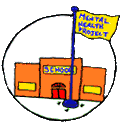

Psychiatrist Glen Pearson is president of the American Society for Adolescent Psychiatry (ASAP). The following is republished with his permission from the society's newsletter.
It happens several times a week in my practice of community child and adolescent psychiatry: Our society's overwhelming belief in medically controlling our kids' behavior finds expression in ever more Huxleyesque demands on the psychiatrist to prescribe. This week's winners are the school district, the juvenile court, and a religious shelter for homeless families with children. Their respective would-be victims are LaShondra, Trevor, and Jimmy.
Jimmy is a 9 year old boy with a long history of treatment for severe emotional disturbance. He's in a school-based day treatment program and seems to be making terrific progress on self-managing his behavior. This turnaround has occurred just in the past few weeks, following an acute psychiatric hospital stay during which the many psychotropic medications he'd been taking without apparent benefit were tapered and discontinued. He was discharged to the day treatment facility and is receiving case management and therapeutic services at home in the community. Unfortunately, the grandmother with whom he lives has been evicted from her residence, and has applied for assistance to a homeless family program. She and Jimmy are scheduled to be admitted to a shelter program next week, but the shelter has made it a condition of receiving services that Jimmy be on medication.
LaShondra is 14. She is in special education classes at her junior high school because of mild mental retardation and emotional disturbance. She bears both physical and psychic scars of early prolonged abuse, and has symptoms of borderline personality pathology and PTSD. She likes school and wants to learn, but keeps getting expelled for behavioral outbursts. The school, too, has made it a condition of her readmittance to classes that she be on medication. LaShondra experiences psychotropic medication as inimical to her emerging adolescent autonomy, and has had negative therapeutic effects during past trials of treatment.
Trevor, at 15, is incarcerated in the Juvenile Detention Center, awaiting a hearing on certification to stand trial as an adult on two charges of capital murder. We have evaluated him for fitness to proceed and determined that he's not mentally ill, but are involved in providing services to Trevor in consultation with the juvenile authorities because he is persistently threatening suicide. We think the best plan is to keep him closely supervised in detention, but the juvenile department is concerned about their liability and petition the court to transfer him to a psychiatric hospital. Two hearings are held on the same day. At the first hearing Trevor is committed to a private facility, on condition that the facility accepts the admission. The facility refuses. At the second hearing, Trevor is committed to the state hospital on condition that the hospital certifies that they can guarantee security. The hospital can't. The Court then orders that Trevor be involuntarily administered unspecified psychotropic agents by injection.
I am not making these things up. These three cases have so far occupied the last three days of my week, and I'm telling you about them not to garner sympathy for the kids (only two of whom have any sympathy coming in any case), or for me (despite my clearly deserving some), but to focus attention on the astonishing degree to which everyone in our society has come to believe in the prescribing of psychotropic medication as a cure, or at least a control, for disturbing behavior in kids.
How did we arrive at this state of affairs? Though a very complex interaction among a myriad of scientific, social, and historical factors, of which I want to mention just two of the scientific ones: progress in psychiatric nosology, and progress in biological psychiatry.
Since 1980, we've trained a generation or two of psychiatrists in the phenomenological approach to diagnosis. The last three editions of the DSM (III-R, and IV) are determinedly atheoretical and empirical in their approach (the majority of members of the Work Groups on Child and Adolescent Disorders for the last three DSM's have been pediatric psychopharmacology researchers), and I think we have long since abandoned trying to teach residents to think about the meanings of symptoms to patients (and ourselves), about the dynamics of intrapsychic structure and interpersonal process. During the same time, the explosive growth of neuroscience and pharmacology has given us many new tools with which to work (if only we knew how: my friend and teacher Bob Beavers used to say, "if the only tool you have is a hammer, everything looks like a nail to you!").
In short, I think we've unwittingly relinquished our most powerful and proven tool: appropriately affectionate, professionally respectful, intimate personal engagement of the patient in mutual exploration of inner meanings. We're frittering our therapeutic potency away on serial trials of psychotropic drugs, and we're prescribing for patients when we don't know the person. There are too many kids on too many drugs, and many of the kids have been given medication as a substitute for engagement and exploration of personal issues.
The point I'm trying to make is that every sector of today's society contributes to this pressure to prescribe. Parents believe medication will cure, schools believe it, courts believe it. even nonpsychiatric mental health professionals believe it. Well, I don't believe it, and it's been my experience with ASAP that most of our members don't believe it either. And, if not only do we not believe that medicine cures, but also we do believe that we have a more powerful and effective treatment which provides an essential context for medication to be helpful, let's stand up and say so. I look forward to hearing from y'all: agree or disagree.
|
School Mental Health Project-UCLA WebMaster: Perry Nelson (smhp@ucla.edu) |
 |